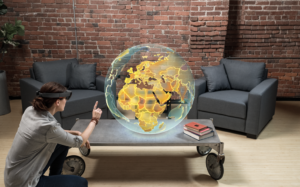Mixed Reality is the result of blending the physical world with the digital world. Mixed reality is the next evolution of human, computer, and environment interaction and unlocks possibilities that before now were restricted to our imaginations. It is made possible by advancements in computer vision, graphical processing power, display technology, and input systems.
Most mobile phones on the market today have little to no environmental understanding capabilities. Thus the experiences they offer cannot mix between physical and digital realities. The experiences that overlay graphics on video streams of the physical world are augmented reality, and the experiences that occlude your view to present a digital experience are virtual reality. As you can see, the experiences enabled between these two extremes is mixed reality: There are two main types of devices that deliver Windows Mixed Reality experiences:
Holographic devices. These are characterized by the device’s ability to place digital content in the real world as if it were really there.
Immersive devices. These are characterized by the device’s ability to create a sense of “presence” – hiding the physical world and replacing it with a digital experience
Content missing
| No | Blog / Tutorial |
| 1 | Extended reality: MR, AR, VR, What’s The Difference? |
| 2 | Enterprise Use Cases for Extended Realty: Augmented Reality & Mixed Reality |
| 3 |

